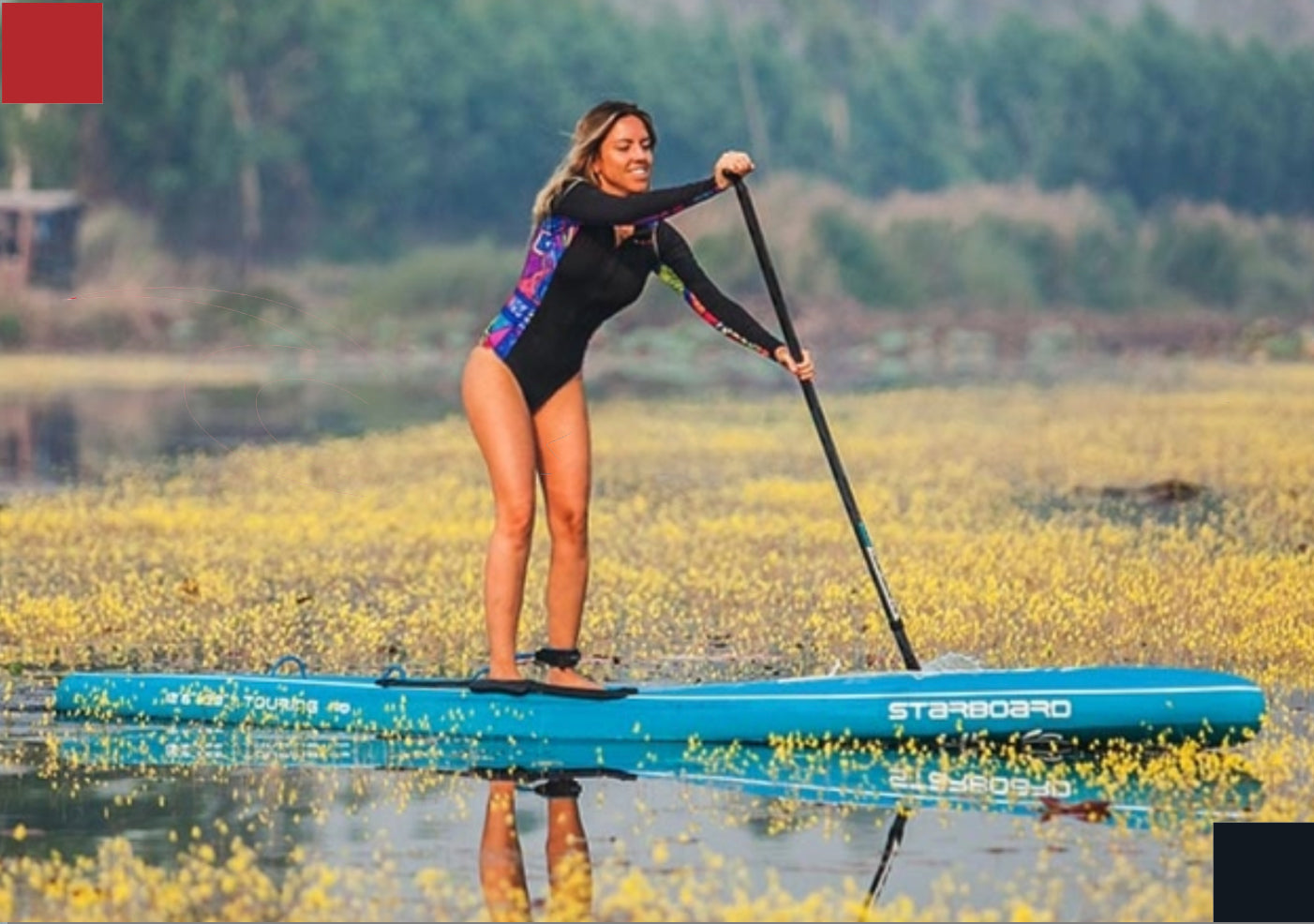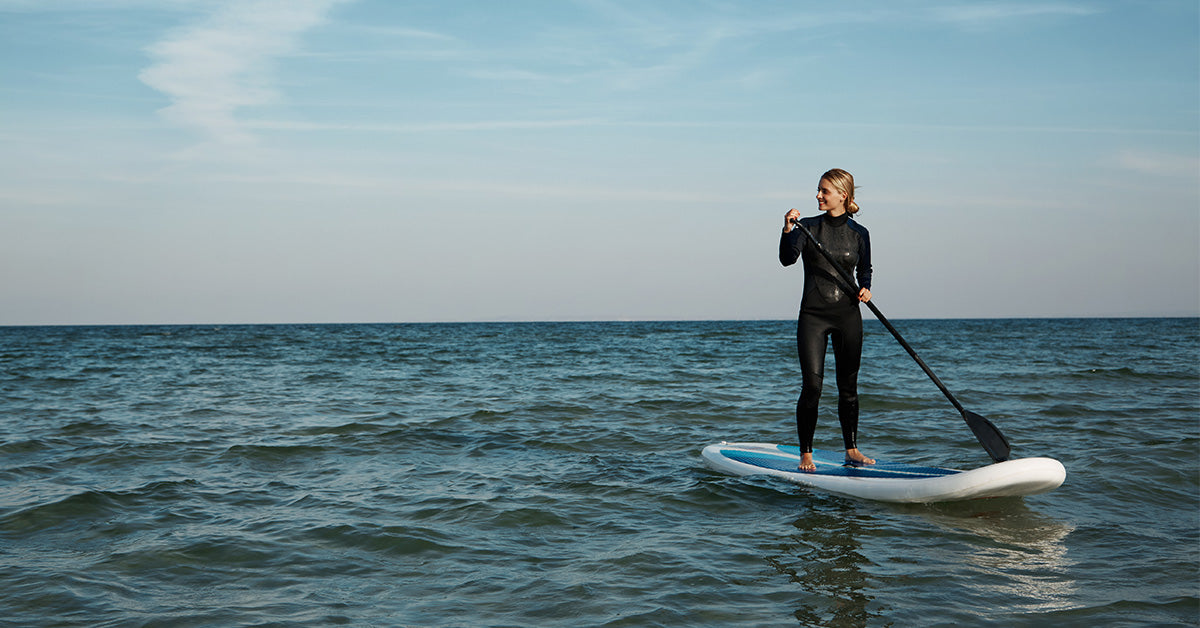
WHAT MAKES THE STARBOARD PADDLE BOARD RANGE SPECIAL?
MATERIALS JOINING PROCESS
Welding is a manufacturing process that involves joining materials, usually metals or thermoplastics, by using high temperature to melt the parts together and allowing them to cool, resulting in a joint.
Adhesive never lasts forever. Starboard's new technology uses a special heat-sealing technique to mechanically bond two separate pieces of PVC into one solid unit. Heat-sealed PVC creates a stronger, more durable, and more environmentally friendly mechanical bond.

Interview with Joe, Managing Director of Starboard
Why did you decide to create welding technology? What was the inspiration? Can you tell us the story of how Welding Tech came to be?
It was three years ago that we started seeing many boards on the market, including our own, beginning to expire and develop problems. We were disappointed by customers who had purchased an inflatable board, used it for a few years, only to discover it was unusable. The glue had broken, causing the board to leak or the seam to open. This was unfair to the customer, who couldn't enjoy our products for a reasonable period of time. At the same time, we were concerned that after just a few years, our products might end up in landfill. As a manufacturer, we felt it was our responsibility to find a better solution, so we started this project.
What were your goals when creating welding technology?
First, we looked at alternative adhesives. We went to the lab to test different types of adhesive. However, we discovered that every adhesive has a limited lifespan, especially when used with PVC. We learned a lot about the parameters that affect adhesive performance. However, we also realized that adhesive would never be the best solution due to its limitations and the way it degrades over time. Therefore, we searched for another solution that would provide a suitable mechanical bond to the PVC layers. This led us to heat welding, to achieve a long-lasting bond between the PVC layers, significantly stronger than any adhesive.
Can you explain the process of developing and developing the technology? How do you test the welding and adhesive? What are the results?
We became convinced that welding could be a good solution. It had already been used in other PVC products, such as super-durable rafting boats and giant inflatables at a water park. However, there were various welding methods that we had to experiment with to fully understand. We did a lot of research, but it turned out that no one had been able to apply this technology to paddleboards. After much research and experimentation on all sorts of materials, we purchased a hot air welder. We had to create our own tools to overcome countless obstacles. After all the experimentation, we determined that the hot air welding method provided the mechanical bond we were looking for. This was the most important thing we wanted to achieve, but we also set ourselves other challenges that we still need to work on solving.
What challenges or problems did you encounter while developing welding technology? How did you solve them?
The development process presented many challenges. The biggest obstacle to drop-stitch welding is all the hairy yarns within the material. This made things very difficult, unlike welding a hollow tube or a rafting boat. To overcome this problem, we had to find the right tools for the job. Experimenting with tools revealed that we were far from achieving the required consistency. The challenge then became finding a comprehensive machine with the tolerances needed to complete the job. We spent months searching the world for machines and the necessary experience working with this challenging material. Ultimately, we had no choice but to test and learn on our own. Once we found the machine, we had to test and understand the key parameters necessary to achieve good results. This technology makes straight-line welding easy, but all paddleboards have curves and corners, which makes things more challenging.
It took a lot of trial and error to get a result we were happy with. When we reached the mass production stage, our factory refused, claiming they had tried it before and failed. After showing them a finished sample, they were still skeptical, so we invited the factory owner and chief engineer to Thailand to demonstrate the process. Once we proved it could be done, we worked with the factory to refine the process to make it practical for production.

ONE PLANT PER BOARD
Producing a board emits approximately 100 kg of CO2. A massive mangrove tree planted to absorb the released CO2 will not only absorb the emissions from production, but will also absorb 1,000 kg of CO2, making each board 10 times carbon positive.
Our mangrove trees are planted by Worldview International Foundation in Myanmar's Thor Heyerdahl Climate Park. To date, we have planted over 500,000 mangroves. This includes a 1-tree-per-board carbon neutral approach, along with emissions detected through life-cycle assessment and carbon footprint analysis. We have calculated that over the next 20 years, all of Starboard's CO2 emissions since 1994 will be absorbed, and much more!
Every year, we calculate our carbon footprint and make the report available for everyone to read, aiming for complete transparency about our impact on the planet. Our entire carbon footprint is offset by the unique CO2 storage capacity of mangroves.
No matter what board you ride, you're helping the environment and being part of a team.


PLASTIC OFFSET PROGRAM
Starboard is guilty of playing a role in the plastics industry, but we are working together to be part of the solution by offsetting our plastic footprint.
Scientists say that by 2050, the ocean will contain more plastic than fish (by weight). As surfers, we experience this with every session on the water, and we see this problem growing at an alarming rate. The problem is here, and we need to act now.
Starboard was the first to provide an internal price for plastic based on consumption. In late 2017, we launched the world's first Plastic Offset Program (POP). We assign a dollar value to each material based on its lifespan, recyclability/bio-based content, and environmental impact, then multiply this value by the amount used to make our products. Funds from the tax go to a pilot program that removes plastic from beaches in Pattaya, Thailand, offsetting the impact of Starboards' plastic.
The POP program encourages us to rethink and reinvent the way we use plastic and further reduce its consumption. Eliminating plastics from production or switching to less harmful varieties and recycled sources (and therefore with lower offset prices) provided incentives to redesign and reduce plastic consumption habits.
By purchasing a board, you help us collect more trash through our plastic offset program. For every board produced, we collect 1.1 kg of plastic beach/ocean trash. This is equivalent to the amount of plastic waste entering the ocean per person per year.

To learn more about Starboard's environmental initiatives, visit Starboard's blue website at
https://blue.star-board.com/


